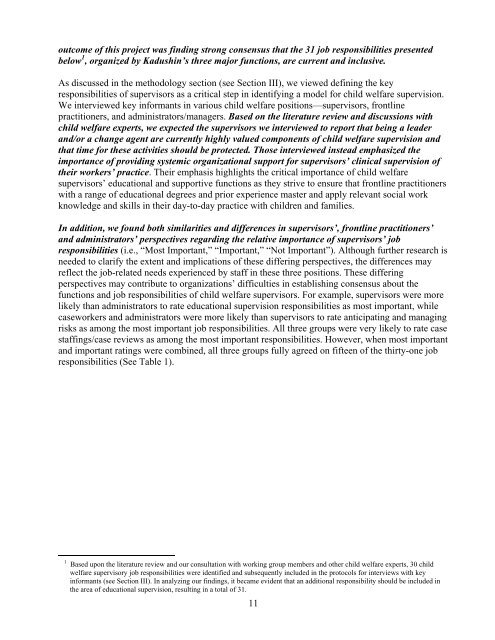Building a Model and Framework for Child Welfare Supervision
Building a Model and Framework for Child Welfare Supervision
Building a Model and Framework for Child Welfare Supervision
- No tags were found...
You also want an ePaper? Increase the reach of your titles
YUMPU automatically turns print PDFs into web optimized ePapers that Google loves.
outcome of this project was finding strong consensus that the 31 job responsibilities presentedbelow 1 , organized by Kadushin’s three major functions, are current <strong>and</strong> inclusive.As discussed in the methodology section (see Section III), we viewed defining the keyresponsibilities of supervisors as a critical step in identifying a model <strong>for</strong> child welfare supervision.We interviewed key in<strong>for</strong>mants in various child welfare positions—supervisors, frontlinepractitioners, <strong>and</strong> administrators/managers. Based on the literature review <strong>and</strong> discussions withchild welfare experts, we expected the supervisors we interviewed to report that being a leader<strong>and</strong>/or a change agent are currently highly valued components of child welfare supervision <strong>and</strong>that time <strong>for</strong> these activities should be protected. Those interviewed instead emphasized theimportance of providing systemic organizational support <strong>for</strong> supervisors’ clinical supervision oftheir workers’ practice. Their emphasis highlights the critical importance of child welfaresupervisors’ educational <strong>and</strong> supportive functions as they strive to ensure that frontline practitionerswith a range of educational degrees <strong>and</strong> prior experience master <strong>and</strong> apply relevant social workknowledge <strong>and</strong> skills in their day-to-day practice with children <strong>and</strong> families.In addition, we found both similarities <strong>and</strong> differences in supervisors’, frontline practitioners’<strong>and</strong> administrators’ perspectives regarding the relative importance of supervisors’ jobresponsibilities (i.e., “Most Important,” “Important,” “Not Important”). Although further research isneeded to clarify the extent <strong>and</strong> implications of these differing perspectives, the differences mayreflect the job-related needs experienced by staff in these three positions. These differingperspectives may contribute to organizations’ difficulties in establishing consensus about thefunctions <strong>and</strong> job responsibilities of child welfare supervisors. For example, supervisors were morelikely than administrators to rate educational supervision responsibilities as most important, whilecaseworkers <strong>and</strong> administrators were more likely than supervisors to rate anticipating <strong>and</strong> managingrisks as among the most important job responsibilities. All three groups were very likely to rate casestaffings/case reviews as among the most important responsibilities. However, when most important<strong>and</strong> important ratings were combined, all three groups fully agreed on fifteen of the thirty-one jobresponsibilities (See Table 1).1 Based upon the literature review <strong>and</strong> our consultation with working group members <strong>and</strong> other child welfare experts, 30 childwelfare supervisory job responsibilities were identified <strong>and</strong> subsequently included in the protocols <strong>for</strong> interviews with keyin<strong>for</strong>mants (see Section III). In analyzing our findings, it became evident that an additional responsibility should be included inthe area of educational supervision, resulting in a total of 31.11
















